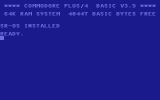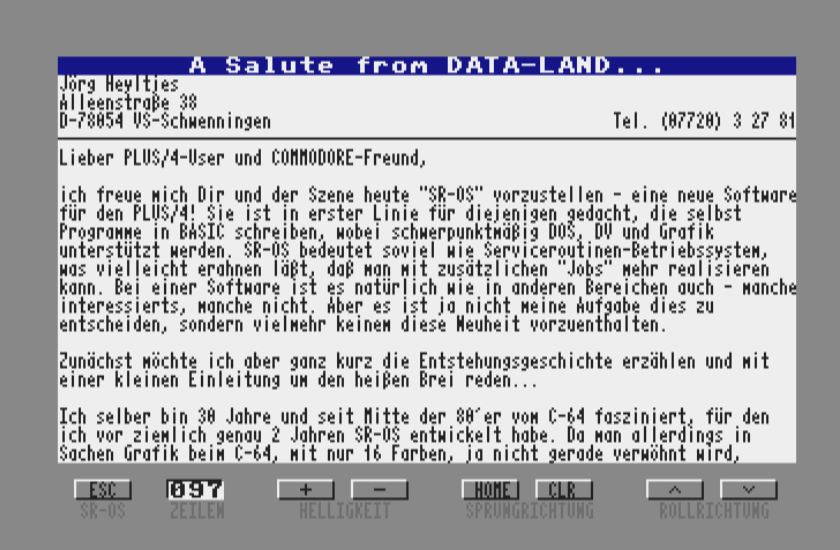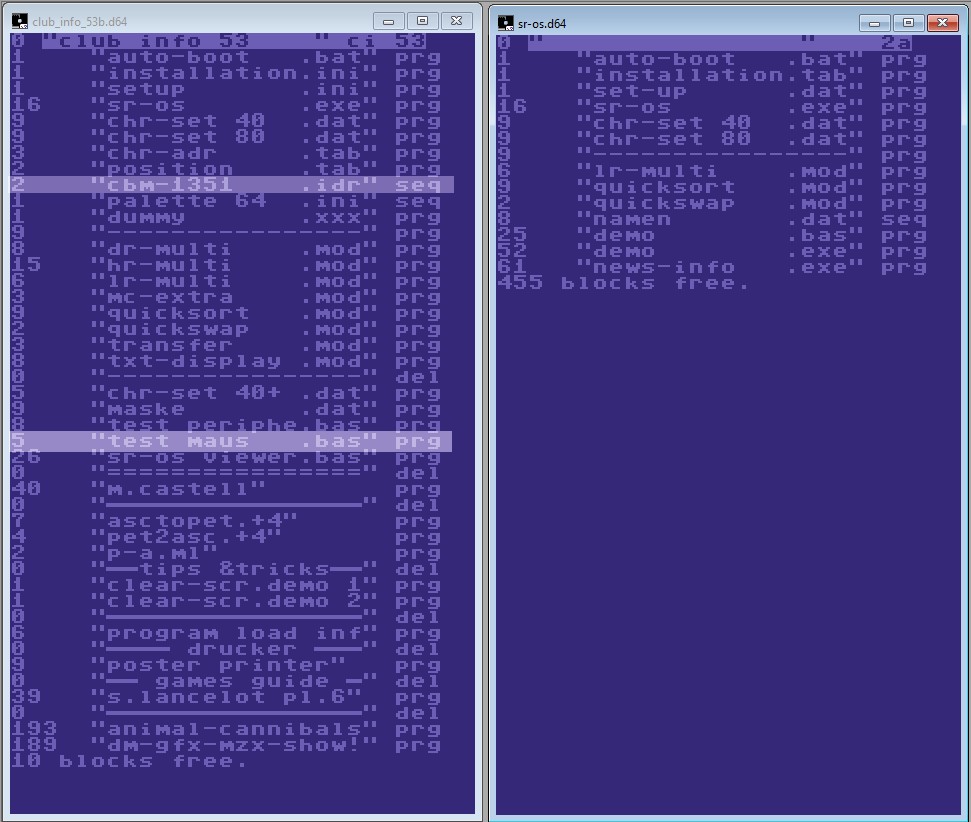| Posted By

MMS
on 2025-02-08
11:39:16
 |  SR-OS SR-OS
| Title: | SR-OS | | Category: | Utility/Programming | | Release Date: | 1990 | | Language: | German | | Size: | 64K | | Device Req.: | Disk only (1 side) | | Machine: | PAL & NTSC | | Code Type: | Basic + Machine code | | Distribution: | Freeware |
|  |
|
|
Posted By

MMS
on 2025-03-04
02:02:42
 |  Re: SR-OS Re: SR-OS
Hello there, I just accidentally found this little gem.
I am still not completely sure of it's capabilities, but the 80 column display test scrolled pretty fast, and as told, it is made in BASIC, makes me curious.
On the D64 there is an executable file made with SR-OS, as it was in German, I translated it to English (sorry if there is any mistranslation. I do no speak German and the text was decoded from screenshots, in the 80 column display it is easy to mix M with H or S with $.
Here is the (draft) translated text, in case reqiored I can copy the German one too (to identify the OCR mistakes). Definitely I will read the Club Info 50 and 53. (and if worth, will translate)
BTW I found DATA-LAND still (kind of) active on C64.
"Dear PLUS/4 user and COMMODORE friend,
I am pleased to present “SR-OS” to you and the scene today, a new software for the PLUS/4! It is primarily intended for those who write programs in BASIC, with DOS, DV and graphics being the main focus. SR-OS means something like service routine operating system, which perhaps suggests that you can implement more utility/programs with additional "jobs". With software it is of course like in other areas - some are interested, some are not. But it is not my job to decide this, but rather not to withhold this humility from anyone.
First of all, I would like to briefly tell you the story of how it came about and give a short introduction to beat the bush...
I am 30 years old and have been fascinated by C-64 since the mid-80s, for which I developed SR-OS almost exactly 2 years ago. However, since you are not exactly spoiled when it comes to graphics with the C-64, with only 16 colors, I was looking for a more colorful alternative that was just as ingenious as the "Cevi". This is what I found last autumn, but I soon lost the comfort and performance of SR-OS, which I had become so used to. So it was clear that I would use SR-OS for the PLUS/4...
At the beginning I deliberately said COMMODORE friend, because this is exactly the group I want to address with SR-OS. Technically, CBM's home computers may have been outdated for a long time, but perhaps it is the typical features that we still value in our "8-BITter" to this day; You can work very DIRECTLY with the computer, do things yourself relatively EASILY, intervene or manipulate the system WITHOUT RESTRICTIONS and if something goes wrong, thanks to the ROMs, the world is in order again, at the latest when you switch it on. In short, you can only really "computer" with a real COMMODORE!
These days we're not exactly drowning in new software and the C-64 has already lost too many good people. So you are called upon to perhaps come up with something new yourself, but more and more people have less and less time... Maybe we are a little spoiled or jealous of our experience with more modern computers and their systems in terms of appearance, comfort and speed!?
My vision for SR-OS was to combine the advantages of BASIC with those of machine language in order to make new programs more interesting and powerful as easily as possible through appearance, comfort and speed. The so-called modules of SR-OS, which take over the time-critical work from BASIC, are crucial for this. This idea isn't actually new when we think about BASIC extensions, but the structure of SR-OS and advantage is that it can come into action in two ways!
No advantage without disadvantage, it's not complicated to program under SR-OS, but I don't want to hide the fact that, as with all new things, you obviously have to learn and it's a bit more complex.
The first impression of such a BASIC program that runs under SR-OS is 2.8. already received here with this message...
However, it is somewhat atypical for a demonstration of sorts; That's why I wrote a small file management in BASIC that uses a total of 18 different "service routines". This is all about showing some SR-OS modules in practice.
I already indicated that SR-OS comes in two forms.
-One is booting, i.e. Han first loads SR-OS and, if necessary, the required modules before (further) writing the BASIC program.
-The second is generating: After the new program has been completed, the BASIC source code, SR-OS and all required modules, graphics, character sets, etc. are "linked" into a single file, with SR-OS being start then generates itself and no longer has to be loaded first! This means you can use this i handy file e.g. B. copy a friend without. that he himself has, knows and needs SR-OS!
If you're interested, you can try both options.
To do this, first establish the switch-on state with a RESET, then load the file “DEMO.EXE” and start it with R-U-N.
You can just as easily boot first with or LOAD" : ",8(...12),1 SR-OS. After the loading processes, you land in direct mode with the push of a button. The message "SR-OS INSTALLED. Afterwards you can load the actual program with LOAD DEMO. BAS",8(...12) and also start it with R-U-N will now appear with the switch-on message.
This file management is actually self-explanatory, but you should first load the archive "HAMER.DAT" FROM the menu so that there is something to "manage" at all.
Finally, I would like to emphasize again that this little demonstration was not about writing a perfect file manager, but rather just demonstrating a few modules in a program.
The remaining modules are in the works and if there is enough response, I will publish the full version in CLUB-INFO.
Please understand that I would have gone beyond the scope of this message with details, but I think it was enough to give you a quick look.
So I would like to thank you for your attention and hope you continue to have fun with the CLUB-INFO and Heiner SR-OS demonstration!
signed Jörg Heyltjes (DATA-LAND/UnLtd.)"
|
|
Posted By

bszggg
on 2025-03-03
14:53:12
|  Re: SR-OS Re: SR-OS
Yeah, it is good enough.
:O

|
|
Posted By

Litwr
on 2025-03-03
21:40:56
|  Re: SR-OS Re: SR-OS
Wow! How can we miss this for so long?!
|
|
Posted By

MMS
on 2025-03-04
00:59:04
 |  Re: SR-OS Re: SR-OS
@bszggg
Surprise!
ClubInfo 53 had n extra release of SR-OS, even containing extra programs, like the 1351 Mouse driver 

|
|
Posted By

Luca
on 2025-03-04
03:10:08
 |  Re: SR-OS Re: SR-OS
@MMS on emulation, it seems to work quite good on VICE, had some weird behavior on YAPE but at least it moves.
Anyway, I'm refreshing that entry right now with these new infos, plus there are minor releases on those disks to put in the archive. As you all can see, we always need a continuous amount of work here 
|
|
Posted By

MMS
on 2025-03-04
13:24:40
 |  Re: SR-OS Re: SR-OS
@Luca thanks your the help. Litwr asked, how we could miss it. I suppose the German scene was almost dead at that time, while the German description limits the possible user base.
I could not go deep enough yet due to time constrains, how it really works, but the sample programs are quite impressive. Just to talk about the 80 column mode, it is much faster, than Kingsoft's realization, and it is a nice achievement
Sstill the list of extra functions and the syntaxis need to be digested, and I will update the page with that info (but first I need to finish the next game  ) )
|
|
| |
Copyright © Plus/4 World Team, 2001-2025. Support Plus/4 World on Patreon |